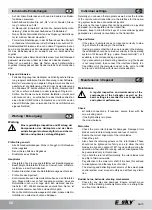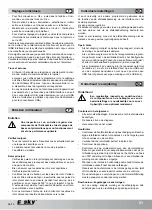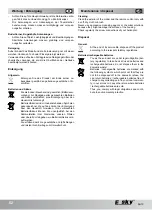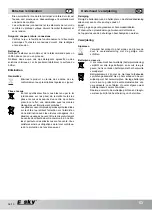
06/10
38
Flugvorbereitung
Flight preparation
Beachten Sie den Ground Effect:
Auftrieb entsteht dadurch, dass die Rotorblät-
ter Luft nach unten drücken. Das erleichtert
das Abheben des Helikopters.
In Bodennähe kann diese Luft aber nur zur Sei-
te ausweichen. Diese seitlich vom Helikopter
wegströmende Luft erzeugt wiederum einen
Unterdruck, der das Modell zu Boden zieht.
Daher ist das Flugverhalten des Modells in ge-
ringer Höhe eher instabil.
Bewegen Sie die Steuerhebel nicht ruckartig.
Landen Sie sofort und korrigieren Sie die notwendigen Ein-
stellungen, wenn Sie Unstimmigkeiten in der Steuerung oder
eine Unwucht im Rotor bemerken.
Steigern Sie die Flughöhe allmählich.
Ab einer Flughöhe von ca. 2 m befindet sich der Helikopter
nicht mehr im Einflussbereich der Luftverwirbelungen aus
dem eigenen Rotor (Ground Effect) und die Fluglage wird
stabiler.
Trainieren Sie die Beherrschung des Modells
Lassen Sie es steigen und sinken, schweben sowie vorwärts
und rückwärts fliegen.
Stellen Sie sich seitlich zum Modell und trainieren Sie die
Steuerung aus diesem Blickwinkel.
Lassen Sie das Modell auf sich zu fliegen und üben Sie die
„umgekehrte“ Richtung der Steuerung
Fliegen Sie Kurven.
Fliegen Sie das Modell immer vor sich.
Wenn Sie das Modell hinter Ihrem Rücken fliegen lassen,
könnten Sie die Orientierung und damit die Kontrolle über
den Heli verlieren.
ACHTUNG!
Wenn Sie nach einigen Minuten merken, dass
die Motorleistung Ihres Elektrohelikopters
nachlässt, so stellen Sie den Betrieb unverzüg-
lich ein, lassen den Flugakku auskühlen und
laden ihn dann wieder nach.
Vermeiden Sie in jedem Fall eine Tiefentladung
des Flugakkus!
Warten Sie mit einem erneuten Flug so lange, bis sich der
Antrieb und die Elektronik des Helikopters abgekühlt hat.
Andernfalls kann es durch die Überhitzung zu einer Beschä-
digung des Antriebs und der Elektronik kommen. Warten Sie
mindestens 10 Minuten, bis der nächste Flug durchgeführt
wird.
Lassen Sie den Akku nicht am Helikopter angesteckt, wenn
Sie ihn nicht benutzen (z.B. bei Transport oder Lagerung).
Andernfalls kann der Akkupack tiefentladen werden, dadurch
wird er zerstört/unbrauchbar!
Wenn Sie nach einigen Flügen ein Gespür für Ihren Helikop-
ter haben, können Sie weitere Optimierungen durchführen.
Lehrer/Schüler-Betrieb
Für erste Trainingsflüge sollten Sie die Hilfe eines erfahrenen
Modellpiloten in Anspruch nehmen.
Dazu können Sie Ihren Fernsteuersender über ein Lehrer/
Schüler-Kabel (nicht im Lieferumfang) mit einer gleich-
artigen Fernsteueranlage eines anderen Piloten verbinden.
Die Anschlussbuchse Ihres Senders befindet sich auf der
Rückseite.
-
-
-
-
-
-
-
-
-
-
-
-
-
-
Observe the ground effect:
The helicopter gets a lift when the rotor blades
push the air downwards. This makes the lifting
of the helicopter easy. When the helicopter is
near the ground, the air can only escape from
the side. This escaping air once again creates a
low pressure and as a result, the model is pul-
led towards the ground. Thus, the model flight
is unstable at a low height.
Do not move the control lever jerkily.
If you notice any inconsistencies in the control system or a
misalignment of the rotor, land immediately and correct the
essential settings.
Increase the flight height gradually.
Above a flight height of approx. 2m, the helicopter is no lon-
ger within the range of influence of air turbulences from its
own rotor (ground effect) and the flight position becomes
more stable.
Practise the model commands
Let it ascend, descend, hover and fly forward and back-
wards.
Stand to the side of the model and practise commanding the
control system from this angle of vision.
Let the model fly towards you and practise commanding the
„reverse“ direction of controls
Practise the curves.
Always fly the model in front of you.
If you fly the model behind you, you could lose the orientation
and thereby the control on the helicopter.
ATTENTION!
If you notice after a few minutes that the mo-
tor power of the helicopter is decreasing, then
stop operation immediately; let the flight batte-
ry cool off then charge it again.
Avoid, in any case, a total discharge of the flight
battery!
Before flying again wait until the drive and the electronics of
the helicopter cool off. Otherwise, the drive and the electro-
nics can be damaged due to overheating. Wait for at least 10
minutes before running the next flight.
Do not leave the rechargeable battery connected to the he-
licopter if the latter is not used (e.g. during transport or sto-
rage). Otherwise, the battery pack can be fully discharged
and thus destroyed/unusable!
If after a few flights you develop a keen sense of your heli-
copter, you can carry out further optimizations.
Trainer/Pupil Operation
You should enlist the help of an experienced model pilot for your
initial training flights.
To do so, use an trainer/pupil cable (not included with model)
to link your RC transmitter to another pilot‘s RC system of the
same type. The connector socket for your transmitter is located
on its rear side.
The pupil‘s transmitter remains switched off
when this is done. The power supply is provi-
ded via the trainer‘s transmitter.
Connect the transmitters with the trainer/pupil cable.
First switch on the trainer‘s transmitter, then the model.
The model will then be controlled only by the trainer‘s trans-
mitter.
-
-
-
-
-
-
-
-
-
-
-
-
-
-
-
-
-
















































